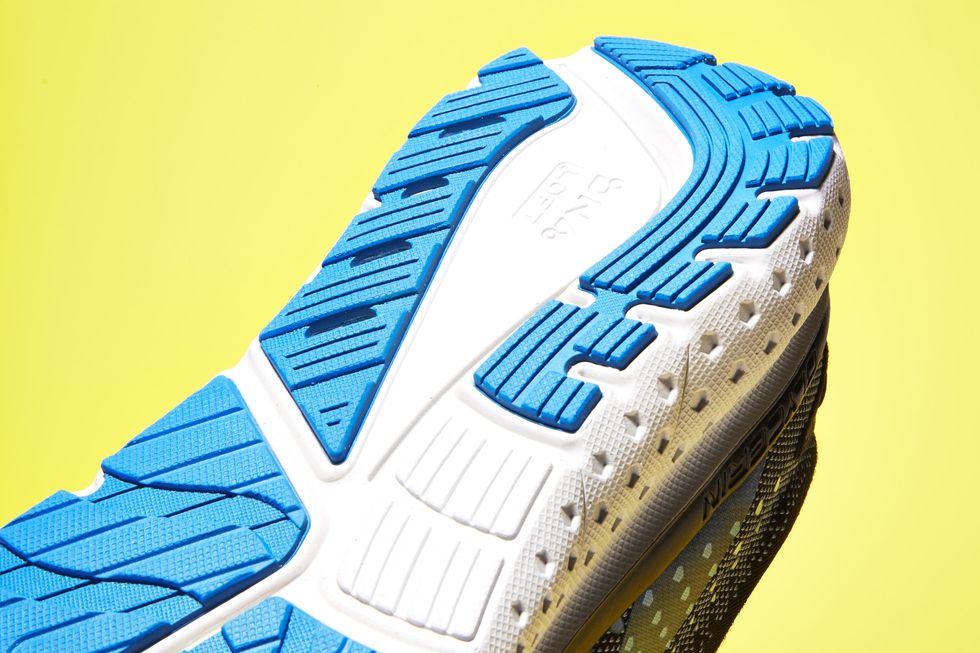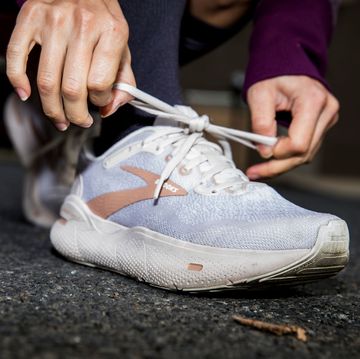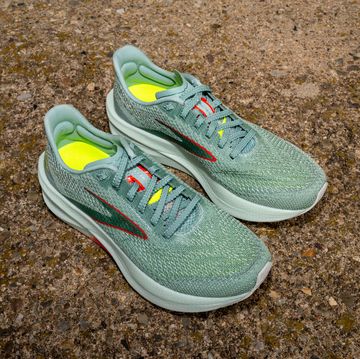Engineered mesh upper allows your feet to breathe: Fans of the Glycerin 17 said the shoe would be even better if it were more flexible and lighter. Brooks listened—and even threw in more midsole foam.
- The Brooks Catamount 2 Is Built for Trail Racing
- The Brooks Catamount 2 Is Built for Trail Racing
- 3D Fit Print saddle and double-jacquard mesh for stretch, breathability, structure
Price: $150
Type: Road
Drop: 12mm (M), 11mm (W)
Weight: 10 oz (M), 8.1 oz (W)
Available: March 1
At some point when I became a runner, I acquired this notion that a cushioned shoe means comfort over speed. It was only recently when I finally came around to putting this belief to bed. What shifted my perception was training in Brooks’s Glycerin and Transcend this past year. When I ran in the Glycerin 17, it was the first time my gait didn’t feel stilted in a cushioned trainer. Instead, the shoe’s soft midsole provided impressive rebound, allowing me to soar instead of holding me back.
The origin of that softness is Brooks’s DNA Loft midsole, which was increased in the Glycerin 18, making for an even cushier feel without losing any of that propulsive energy return. The shoe provides all-around comfort in a seamless upper, and a structured, secure fit with a stretchy 3D Fit Print saddle. Our testers praised the shoe’s flexibility.
“This is the first shoe in which I was more fully aware of each footstrike with the road,” said one. “It was such a gentle, smooth transition that was dramatically different from the stiff, slapping feel of my last shoes.”
At The Runner’s World Shoe Summit back in November (days before the New York City Marathon), a Brooks rep holding the 18 in his hands said what could be regarded as the Glycerin’s slogan: “More comfort means faster running.” Judging by how forgiving it feels on my legs when I lay on a few surges, I couldn’t agree more with this statement.
Minor Improvements for a Better Ride
Testers raved about the 17’s softness and how comfortable the Glycerin felt on their run—so comfortable that they’d keep wearing the trainers long after they’d homed in that last mile. But their praise wasn’t without some critique. Some wished that the shoe was lighter (our lab scores rated the 17 as a “heavy” shoe compared to the average trainer); others wanted more flexibility. Somehow, Brooks delivered on both fronts, making the Glycerin 18 less hefty, more pliable, and, somehow, with even more midsole foam.
Our shoe lab results put the 18 in the middle of the spectrum in terms of weight. The women’s model lost tenths of an ounce while the men’s had a more dramatic drop from 11 to 9.8 ounces. Scores also showed the 18 as “stiff” to “moderately flexible”; results for the 17, on the other hand, read “very stiff.”
When “Moderate Cushioning” Feels Just Right
Remarkably, our measurements showed cushioning in the heel and forefoot as “moderate,” as well; a departure from the Glycerin’s usual score of “very soft.” However, our testers didn’t complain that Brooks’s cushiest shoe had lost its soft touch. Instead, in that Goldilocks realm of not being too soft nor too firm, they found the moderately cushioned platform to feel just right.
“This shoe provided amazing cushioning with a comfortable fit and a luxurious ride!” said a tester. “It feels lighter than the Glycerin 17 and responds to the road better, almost springing with each stride. It’s a smooth ride with a seamless transition from the heel to the forefoot.”
More Wear Tester Feedback
Arch: High | Neutral | Footstrike: Midfoot
Emily J., tester since 2014
“This shoe is one of the best I have tested in the past five years. The most exemplary qualities include the cushioning, support, and comfort. It is a very well-rounded shoe that addresses a variety of my needs. I primarily tested this shoe on roads, both wet and dry, and at various speeds from slow jog to sprinting.”
Advertisement - Continue Reading Below
Arch: High | Neutral | Footstrike: Midfoot
“The plush feel and cushioning of this shoe, combined with the soft, rubberized sole, can make the shoe seem more soft and spongy—but I was not aware of expending extra energy even when using them for speed work—it only made the longer runs that much more enjoyable. The cushioning in the sole feels active and responsive, leading to more bounce in my stride.”
Amanda is a test editor at Runner’s World who has run the Boston Marathon every year since 2013; she's a former professional baker with a master’s in gastronomy and she carb-loads on snickerdoodles.
















